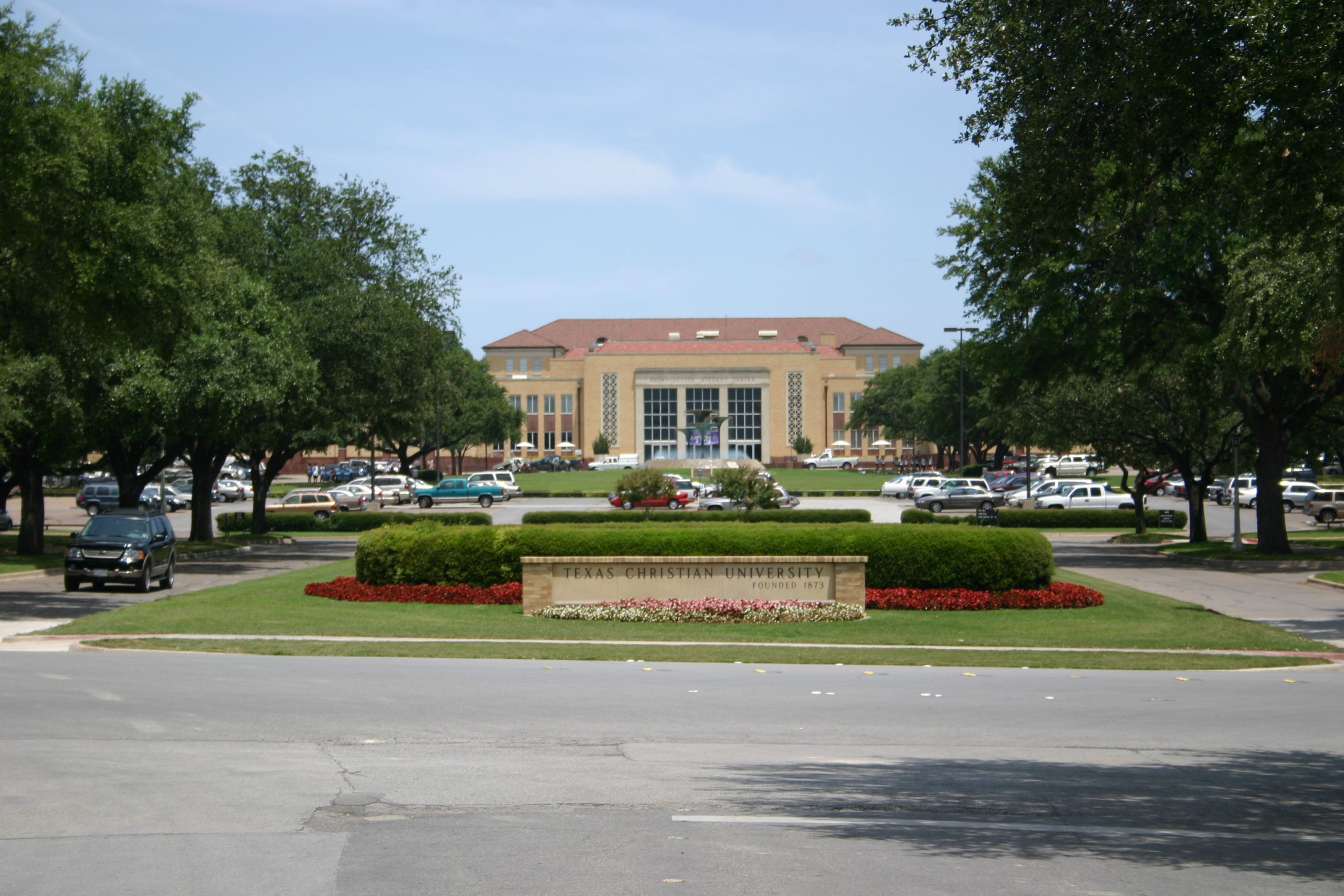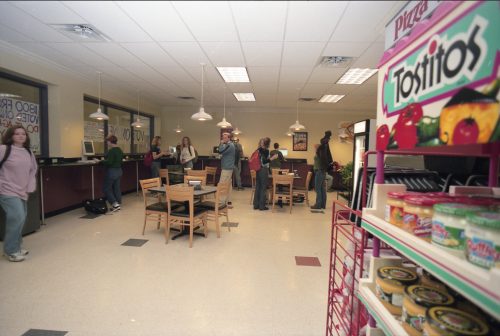
Still a lively student gathering spot, Frog Fountain looks much the same as it did in the 1990s — unlike its ever-evolving surroundings. Courtesy of TCU Library Special Collections
Where We Hung Out: TCU’s Lost ’90s Landmarks
TCU’s campus has seen seismic change over the past quarter century, but the memories remain.
LIKE THE BACKSTREET BOYS, THE ’90S ARE BACK. Jelly sandals are cool again, crop tops are seemingly unavoidable in clothing stores and inflatable furniture is, apparently, still a thing. The same applies to entertainment and technology, with the return of Polaroid cameras, Tamagotchis and people binge-watching Bob Ross’ The Joy of Painting online to self-soothe.
This revival is particularly popular with Generation Z, or people born between 1997 and 2012. Over 97 percent of current TCU undergraduates are Gen Zers under age 25, reports TCU Institutional Research.
No matter how trendy the era has become, there are some ’90s experiences today’s Horned Frogs can’t simulate, such as grabbing lunch at Pizza Hut in the Brown-Lupton Student Center or watching the sunset from the upper deck of the old football stadium.
Some hot spots on and near campus, like Frog Fountain and Perrotti’s Pizza, have stuck around since the ’90s, while others have closed, relocated or changed completely.
The Brown-Lupton University Union is an arched, three-story building with a clock tower, dining options and a plaza on the far end of the Campus Commons, a grassy stretch of lawn in front of Frog Fountain. But in the 1990s, the lawn was a parking lot separating Frog Fountain from the football stadium. The University Union, then called the Brown-Lupton Student Center, stood where Scharbauer Hall sits now and housed the bookstore, a Pizza Hut and a cafeteria often called the Main.

TCU had a different look in the 1990s, when a parking lot covered the area that now houses the Campus Commons. Courtesy of Keith Robinson
Don Mills ’72 MDiv, vice chancellor for student affairs from 1993 to 2011, said the student center was a hub of activity, and it was common to hear people say, “I’ll see you at the Main.”
“If you were going to go anywhere in the student center,” he said, “you had to go right by that main cafeteria. … There was a lot of informal socializing there. It was terrific.”
The bookstore was on the lower level of the student center, and while its selection wasn’t as big as today’s, alumna Stephanie Wellman ’95 said it was a solid resource. It also had a “send-home” payment option where students could forward the bill to their parents.
“I liked it,” Wellman said, “because you could use your send-home to get mac and cheese or some Tide or little sundries, emergency things, whatever you needed.”
Multiple alumnae said they remembered stocking up on Lancôme and other not-quite-essentials — much to their parents’ frustration, Kristel Vaught Jech ’95 said. “My dad still talks about the send-home bill.”
The Notorious P.I.T.
While most TCU students today weren’t around campus in the ’90s, at least one recent graduate was. Molly Beckman Kanthack ’95 (EMBA ’25), who is executive director of brand activation for her alma mater, met her husband as a TCU undergraduate, and her sister-in-law and brother are also Horned Frogs. She said one of the best memories was spending time with her brother on campus. “Those were some of the best four years of my life.”
Kanthack and friends often grabbed dinner from the student center but ate by the fountain. “That was our main dining hall, so a lot of times we would just take food outside,” she said, “and sit around Frog Fountain or listen to a band.”

Students work at a computer station in the Brown-Lupton Student Center in November 1999. The center was a prime gathering spot and included a Pizza Hut and a cafeteria called the Main. Courtesy of TCU Library Special Collections | Linda Kaye
The student center was also home to “the Pit,” another popular stop for students who wanted to dine on campus. Jech said the Pit contributed to her “freshman 15,” referring to how students sometimes gain weight when starting college. “I usually grabbed something to take to study hall,” she said. “I drank so much fruit punch.”
When the Main wasn’t open, Jech said the Pit would get crowded, especially between lunch and dinner. “You also had to pick up football tickets at a certain time in the Pit,” she said. “I missed a few games because I missed ticket pickup.”
Alan Melson ’00 said Pizza Hut served as the backdrop for fun times with his fellow marching band members. “I have happy memories of many hours sitting in there talking with friends during lunch or after classes.”
When he wasn’t in the student center, at band practice or DJing for the KTCU radio studio, he also enjoyed taking in the view from the seats of Amon G. Carter Stadium. “The old stadium back then was left open most of the time,” he said, “so it was fun to go up in the upper deck and watch the sunset.”

The Brown-Lupton Student Center, home to “the Pit” and other popular student spots, circa 1999. Courtesy of TCU Library Special Collections | Linda Kaye.
Wellman, meanwhile, was listening to music on a boom box with her sorority sisters and keeping up with the latest TV shows. “When Melrose Place started, I lived in the Pi Phi house,” she said, “and I had a big Melrose watching party for the very first episode.”
Other alumni shared a ’90s memory: visiting Flash Photo.
The store on University Drive that now sells apparel and other school merchandise developed prints captured at parties and other campus events. Photos were hung on a clothesline for students to view and purchase. Alumni said they would run to Flash Photo after raucous parties to see if they were in any pictures — and to remove embarrassing ones.
“One hundred percent, I was one of those people,” Kanthack said. Mills chuckled at these anecdotes. “As administrators, we never went to check.”
Smells Like Team Spirit
In 1999, Melson was inspired to write an article for the student publication Image Magazine about a strip of shops on University Drive. The block of shops and restaurants situated at the intersection of South University Drive and West Berry Street is now home to the TCU bookstore and several restaurants. But Flash is the strip’s only holdover from the ’90s.
Melson, who studied broadcast journalism, said he wanted to illustrate the area’s history for readers and explore how it had evolved since the late 1920s. “I loved history and was interested in the history of the TCU area,” he said, “so I pitched the story idea to the Image Magazine editor, and they approved it.”
After combing through old copies of The Skiff and the Fort Worth Star-Telegram, he interviewed the owners of Jon’s Grille and Record Town, the street’s only record shop. His article highlighted the different shades of school spirit and touched on a hot topic in Fort Worth at the time: the Berry Street Initiative.
Mills said West Berry Street was a rough place in the ’90s, often called “Scary Berry” for its crime and poor walkability. The result was the Berry Street Initiative, a local group formed in 1996 and dedicated to improving West Berry Street through development and city funding.
“There were a lot of issues along there,” he said of the street. “During the ’90s, TCU made a real effort, in partnership with the city, to develop Berry Street as a more pedestrian and safer place.”
“I mean, yes, the campus looks different, but the faculty still, [their] doors are open … and they’re here to support you along the way.”
Molly Beckman Kanthack
Mills said this was also an era of change for TCU because it began building more student housing, encouraging students to spend more time on campus and promoting school spirit with weekly pep rallies and other events.
“We began to have a lot more school spirit,” he said. The school’s status in athletics also changed in the ’90s, Melson said. TCU had been abandoned by four members of the Southwest Conference and had a more regional profile. All that changed when the school hired Dennis Franchione as the head football coach in 1998.
“It was smaller,” Melson said of the school, “and, looking back, [it was] right on the cusp of gaining a larger status. … It was nothing like you see today.”
The More Things Change
Efforts to increase housing, revitalize West Berry Street and elevate TCU Athletics are still alive today. The TCU Campus Master Plan illustrates the school’s vision for campus growth, including renovating and constructing new athletic facilities, creating a residential village for east campus and further developing the Berry Street corridor.
While TCU was different in the ’90s, some details remain constant. Students continue to gather at Frog Fountain, grab dinner on University Drive, battle for good parking spaces and rub the horned frog statue’s nose for good luck.
Kanthack is now working with students and supporting them the way she said faculty and advisers helped her. She and Wellman have children attending TCU. Despite the new buildings and facilities, Kanthack said, the feeling of community is steadfast.
“In this many years, that has not changed,” she said. “I mean, yes, the campus looks different, but the faculty still, [their] doors are open … and they’re here to support you along the way.”

Your comments are welcome
1 Comment
I remember TCU in 74 to 78 and the student center steps was the place to meet and hangout. We also had parties in some of the rooms on the second floor. I am from NY and had not visited much and was so surprised when I did. Good memories and made life long friends….
Related reading:
Features
Gathering Place
After a controversial start, Frog Fountain is now the heart of Campus Commons.
Campus News: Alma Matters
Step Onto Campus
For more than half of first-year Horned Frogs, the student-led campus tour is where it all begins.
Mem’ries Sweet
Trading Places
The Big Switch gave a student a taste of the chancellor’s day while the chancellor went back to class.